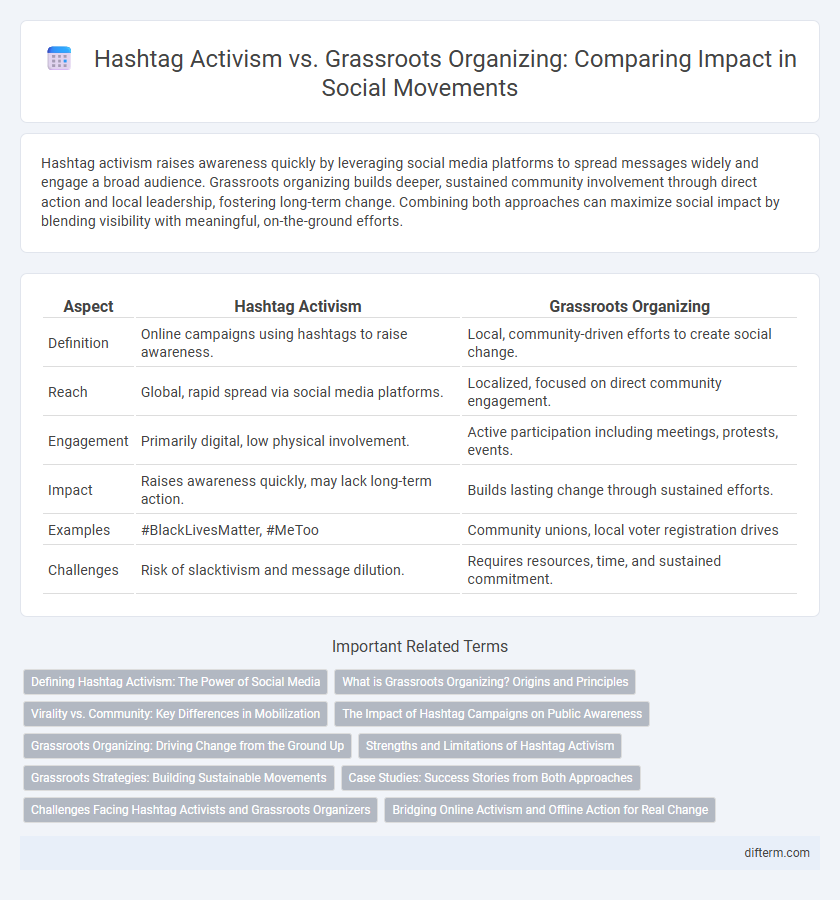Hashtag activism raises awareness quickly by leveraging social media platforms to spread messages widely and engage a broad audience. Grassroots organizing builds deeper, sustained community involvement through direct action and local leadership, fostering long-term change. Combining both approaches can maximize social impact by blending visibility with meaningful, on-the-ground efforts.
Table of Comparison
| Aspect | Hashtag Activism | Grassroots Organizing |
|---|---|---|
| Definition | Online campaigns using hashtags to raise awareness. | Local, community-driven efforts to create social change. |
| Reach | Global, rapid spread via social media platforms. | Localized, focused on direct community engagement. |
| Engagement | Primarily digital, low physical involvement. | Active participation including meetings, protests, events. |
| Impact | Raises awareness quickly, may lack long-term action. | Builds lasting change through sustained efforts. |
| Examples | #BlackLivesMatter, #MeToo | Community unions, local voter registration drives |
| Challenges | Risk of slacktivism and message dilution. | Requires resources, time, and sustained commitment. |
Defining Hashtag Activism: The Power of Social Media
Hashtag activism leverages social media platforms like Twitter and Instagram to rapidly raise awareness and mobilize support for social causes through concise, shareable tags such as #BlackLivesMatter and #MeToo. This digital form of activism facilitates global participation and instant dissemination of information, often sparking viral movements that pressure policymakers and corporations. While effective in amplifying voices and narratives, hashtag activism relies heavily on online engagement metrics, which can sometimes limit sustained, tangible change without complementary grassroots organizing efforts.
What is Grassroots Organizing? Origins and Principles
Grassroots organizing is a community-driven approach to social change that originates from local, often marginalized groups mobilizing to address systemic issues through direct action and collective empowerment. Rooted in principles of bottom-up leadership, inclusivity, and sustained engagement, it emphasizes building relationships and fostering long-term community capacity rather than relying solely on digital platforms. Unlike hashtag activism, which primarily raises online awareness, grassroots organizing creates tangible impact through face-to-face interactions and localized strategies for social justice.
Virality vs. Community: Key Differences in Mobilization
Hashtag activism drives rapid virality by leveraging social media platforms to spread messages instantly to a broad audience, creating widespread awareness but often lacking sustained engagement. In contrast, grassroots organizing builds deep community ties through face-to-face interactions, fostering long-term commitment and collective action beyond online visibility. The key difference lies in hashtag activism's emphasis on quick, viral reach versus grassroots organizing's focus on nurturing strong, localized networks for durable social change.
The Impact of Hashtag Campaigns on Public Awareness
Hashtag campaigns significantly amplify public awareness by rapidly disseminating social issues across diverse digital platforms, reaching millions of users worldwide. These campaigns facilitate immediate engagement and viral sharing, creating a collective voice that pressures institutions to respond. However, their impact often depends on sustained online activity and offline efforts to translate awareness into tangible social change.
Grassroots Organizing: Driving Change from the Ground Up
Grassroots organizing fosters community-driven change by empowering local individuals to address social issues directly, creating sustainable and impactful movements. This approach leverages personal relationships and collective action to build trust, mobilize resources, and influence policy effectively at the local level. Unlike hashtag activism, grassroots efforts focus on long-term engagement and tangible outcomes through face-to-face collaboration and ongoing advocacy.
Strengths and Limitations of Hashtag Activism
Hashtag activism leverages social media platforms like Twitter and Instagram to rapidly amplify awareness and mobilize global support for social causes, making it a powerful tool for visibility and online engagement. Its strength lies in the ability to connect diverse audiences and spark viral campaigns with minimal resources, yet it often suffers from limitations such as slacktivism, where online participation lacks tangible offline impact. The ephemeral nature of hashtags can hinder sustained activism efforts, affecting long-term policy change and grassroots empowerment.
Grassroots Strategies: Building Sustainable Movements
Grassroots strategies prioritize community-driven actions that foster long-term commitment and local leadership, enabling movements to sustain momentum beyond viral moments typical of hashtag activism. These approaches emphasize organizing people around shared interests and tangible objectives, creating resilient networks through continuous engagement and resource development. Building sustainable movements requires investing in education, coalition-building, and direct action to address systemic issues at their roots.
Case Studies: Success Stories from Both Approaches
Hashtag activism, exemplified by #BlackLivesMatter, mobilized global awareness rapidly through social media platforms, sparking widespread conversations on racial justice and influencing policy debates. Grassroots organizing, as seen in the Montgomery Bus Boycott, demonstrated sustained community engagement leading to tangible legislative changes and long-term social transformation. Both approaches leverage different mechanisms of action--digital amplification versus local coalition building--to achieve significant social impact in movements for equality and civil rights.
Challenges Facing Hashtag Activists and Grassroots Organizers
Hashtag activism faces challenges such as digital performativity, where online engagement may not translate into real-world impact, and algorithmic limitations that restrict message visibility. Grassroots organizers confront obstacles including resource constraints, community trust-building, and physical mobilization amid political or social barriers. Both movements struggle with sustaining momentum and ensuring that awareness leads to tangible policy changes or social reform.
Bridging Online Activism and Offline Action for Real Change
Hashtag activism mobilizes widespread online support through viral campaigns using targeted hashtags like #BlackLivesMatter, amplifying marginalized voices and raising urgent social issues. Grassroots organizing builds local, community-based networks that coordinate offline actions such as protests and voter drives, fostering sustained, tangible change through direct engagement. Combining digital outreach with on-the-ground efforts creates a powerful synergy that transforms online awareness into impactful, real-world social movements.
hashtag activism vs grassroots organizing Infographic

 difterm.com
difterm.com